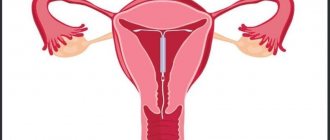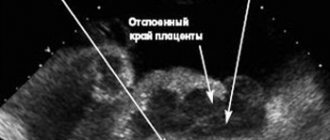Composition and release form
Mifepristone is produced in the form of round yellow tablets with a concentration of the active component of 50 or 200 mg. The medicine is packaged in 3, 6 or 10 pcs. in blister packaging or a polymer jar. 1 cardboard box contains 1 can, 1, 2 or 5 packages, instructions for use. Chemical composition of Mifepristone:
| Release form | Active ingredient | Excipients |
| Tablets, 1 pc. | mifepristone (50 mg) | carboxymethyl starch; milk sugar; potato starch; microcellulose; magnesium stearate; polyvinylpyrrolidone. |
| Tablets, 1 pc. | mifepristone (200 mg) | microcellulose; calcium stearate; lactose; corn starch; Aerosil (colloidal silicon dioxide). |
Mifepristone - additionally:
Patients are informed that if therapy is ineffective, the pregnancy will need to be terminated surgically (the possibility of congenital malformations in the fetus).
Breastfeeding is stopped for 14 days after administration. The use of the medicine requires the prevention of Rh alloimmunization and other general measures accompanying abortion. Use only in hospitals. Patients with prosthetic heart valves or infective endocarditis should receive prophylactic antibiotic treatment when using mifepristone. , Russia 249030, Kaluga region, Obninsk Important! You should consult your doctor before using Mifepristone This instruction is intended for informational purposes only.
How does Mifepristone work?
This steroid drug is approved for use in all countries of the European Union, except Poland, Lithuania, Ireland and Malta, where abortion is officially prohibited. According to the instructions, Mifepristone blocks the synthesis of progesterone, as a result of which it provokes uterine bleeding (menstruation). The drug releases interleukin-8 in choriodecidual cells and increases the sensitivity of the myometrium to prostaglandins. Desquamation of the decidua occurs, and the fertilized egg is expelled.
After using a single dose of 600 mg, the maximum concentration in plasma of the active substances is reached after 1.3 hours. The bioavailability of Mifepristone is 69%, binding to plasma proteins is 98%. The half-life is 18 hours. The medication is removed from the body in 2 stages: first slowly until the concentration of the active substance is reduced by half, then quickly.
Mifepristone - method of administration:
The drug should be used in institutions that have appropriately trained medical personnel and the necessary equipment. For medical termination of pregnancy: a single dose of 600 mg of mifepristone is taken orally in the presence of a doctor, 1-1.5 hours after a meal (light breakfast), washed down with half a glass of boiled water. In order to enhance the effect of mifepristone, a synthetic analogue of PgE1 is prescribed - 400 mg of misoprostol. The patient should be under the supervision of medical personnel for at least 2 hours after use. 36-48 hours after taking mifepristone, the patient should appear for ultrasound control. After 8-14 days, a clinical examination and ultrasound control are repeated, and the level of beta-hCG is determined to confirm that a miscarriage has occurred. If there is no effect from the use of the medicine on day 14 (incomplete abortion or ongoing pregnancy), vacuum aspiration is performed, followed by histological examination of the aspirate. To prepare and induce labor: a single dose of 200 mg of mifepristone orally in the presence of a doctor. After 24 hours, repeat administration of 200 mg. After 48-72 hours, the condition of the birth canal is assessed and Pg or oxytocin is prescribed if necessary.
Indications for use
Mifepristone tablets are prescribed to speed up delivery during full-term pregnancy. The second purpose of the drug is early medical abortion (up to 9 weeks). Other indications are described in the instructions for use:
- dilatation of the cervix for up to 12 obstetric weeks before surgical termination of pregnancy;
- induction of labor due to fetal death in the second half of pregnancy;
- psychotic depression;
- uterine fibroids or benign uterine tumors;
- emergency contraception.
Related articles Misoprostol how it works Abortion pills How a medical abortion is done
Mifepristone - contraindications:
Hypersensitivity, a history of hypersensitivity to mifepristone, adrenal insufficiency and long-term corticosteroid therapy, acute or chronic renal and/or liver failure, porphyria, uterine fibroids, presence of a uterine scar, anemia, hemostasis disorders (including previous treatment anticoagulants), inflammatory diseases of the female genital organs, the presence of severe extragenital pathology.
It is forbidden to use by smoking women over 35 years of age (without prior consultation with a physician). To terminate pregnancy: suspicion of an ectopic pregnancy, pregnancy not confirmed by clinical studies, exceeding 42 days after the cessation of menstruation, occurring during the use of an IUD or after discontinuation of hormonal contraception. For preparation and induction of labor: severe gestosis, preeclampsia, eclampsia, premature or post-term pregnancy. With caution. COPD (including severe forms of bronchial asthma), arterial hypertension, heart rhythm disturbances, CHF. Interaction with other drugs: The use of nonsteroidal anti-inflammatory drugs (NSAIDs), including acetylsalicylic acid, should be avoided. they may affect the effectiveness of treatment.
Directions for use and dosage
To terminate a pregnancy, a patient in a special medical institution is prescribed a single dose of 600 mg of Mifepristone (3 tables). The recommended dose should be taken orally in the presence of a doctor 1 hour after a light meal, followed by 0.5 tbsp. water. The patient remains under medical supervision for another 2–3 hours. After 2 days, you need to go to a medical facility and perform an ultrasound. After 2 weeks it is necessary to conduct a control ultrasound. In the absence of positive dynamics, the gynecologist prescribes vacuum aspiration.
How long does it take for Mifepristone to start working?
To stimulate labor during full-term pregnancy, the patient is prescribed 1 tablet. Mifepristol per day (200 mg). After 48–72 hours, obstetricians assess the condition of the birth canal and, if necessary, additionally prescribe Oxytocin or prostaglandins. Labor begins within 10 hours from the moment the indicated dosage is applied. According to the instructions, the drug is not administered intravenously.
Mifepristone and Misoprostol
To terminate an early pregnancy, it is recommended to use Mifepristone and Misoprostol tablets at the same time. The first medication softens the cervix, the second provokes expulsion of the fetus and uterine contractions. The doctor determines the treatment regimen individually (depending on the choice of the manufacturer of these drugs). The combined reception is carried out only in the hospital.
How to use Mifepristone
The hormonal drug can only be used on an outpatient basis under the supervision of a physician. Taking the drug is possible only after ultrasound confirmation of intrauterine pregnancy for up to 6 weeks.
To terminate pregnancy up to 6 weeks, the drug is prescribed at a dose of 600 mg. 3 tablets must be taken at a time (in the presence of an observing gynecologist) 1-2 hours after a light breakfast. Due to possible side effects, the patient is observed for another 2-5 hours after taking the pills. If necessary, an additional drug based on misoprostol is prescribed.
After 2 weeks, when vaginal bleeding has completely stopped, the woman should visit the clinic again for an ultrasound, which will confirm or deny the successful termination of pregnancy. The control examination also includes the determination of human chorionic gonadotropin, the level of which will indicate whether the pregnancy continues or not.
If, 2 weeks after taking the drug, pregnancy continues or an ultrasound shows partial release of the fertilized egg from the uterus, additional surgical intervention will be required - vacuum aspiration or curettage.
To speed up the labor process, Mifepristone is prescribed 1 tablet per day. If necessary, another tablet is prescribed 24 hours after the first. If labor has not begun 72 hours after the second dose, the patient is additionally prescribed oxytocin or prostaglandins.
For the treatment of a benign tumor of the uterus, the doctor selects the dosage and frequency of administration individually.
special instructions
The woman is warned: if medical termination of pregnancy does not produce results within 14 days, it is necessary to use another method, for example, vacuum aspiration. Otherwise, the child is born with serious pathologies.
Other instructions from gynecologists are described in the instructions for use:
- Mifepristone does not affect the speed of psychomotor reactions, therefore, after taking the tablets, you are allowed to drive a vehicle and engage in types of work that require increased concentration.
- Before a medical abortion, it is necessary to undergo a series of laboratory tests to promptly prevent the development of Rh alloimmunization.
- Women with a prosthetic heart valve or infective endocarditis should first receive prophylactic antibiotic treatment.
- After using Mifepristone, the doctor will order tests to determine the level of human chorionic gonadotropin.
How to take Mifepristone
You should immediately forget about taking pills at home. The entire procedure must be carried out under the supervision of medical personnel. If you have a different opinion on this matter, read the last part of the article about medical abortion.
The first visit to the doctor is necessary for consultation, as well as collection of necessary tests.
- These include a blood test. It is necessary to establish the group in advance, since blood may be needed for an urgent transfusion, and find out the number of red blood cells (this will allow you to understand whether you have anemia).
- Testing for sexually transmitted infections.
- Ultrasound will help to accurately determine the gestational age of the fetus and identify ectopic pregnancy in advance.
Depending on the technical capabilities of the clinic, tests can be obtained on the same day of treatment, which means that an abortion can be performed on the same day.
According to the instructions for use for Mifepristone, the effectiveness of the tablets increases if taken in combination with Misoprostol. But on the first day you will only take the first drug.
Dosage – 3 tablets , washed down with water (you cannot take the drug on a full stomach).
You will have to spend the next 2-4 hours after your appointment in the hospital under the supervision of staff. This is necessary in order to prevent side effects. According to statistics, in half of cases a complete miscarriage occurs in the first few days after an abortion.
If this does not happen, you need to go back to the hospital to take additional prostaglandins.
How long does it take for the drug to start working?
- within 4 hours – in 35% of patients;
- within 6-7 hours – in 10% of patients;
- within 24 hours – in 55% of patients.
24 hours after the abortion, it is necessary to undergo additional examination to exclude the possibility of an ongoing or incomplete pregnancy. If it is successful, then further preventive medications are also prescribed by the doctor and only based on the test results.
Side effects of Mifepristone
According to patient reviews, the drug is poorly tolerated by the body. Mifepristone often causes side effects that temporarily make a woman feel worse. Potential complaints:
- nausea, less often – vomiting;
- increased body temperature;
- general weakness, dizziness, asthenia, internal restlessness, insomnia;
- lochiometer (delay of discharge from the uterine cavity);
- bleeding from the vagina;
- the addition of a secondary infection in the pelvic organs (vaginitis, vaginosis, candidiasis);
- heart rhythm disturbances, arrhythmia;
- discomfort in the abdominal area;
- headache, migraine;
- allergic reactions, hyperthermia.
Contraindications
Oral use of Mifepristone to expel the fetus from the uterine cavity is not permitted for all women. For example, if the body is hypersensitive to the active substances, the drug is not prescribed. The instructions provide a comprehensive list of medical contraindications:
- amenorrhea;
- long-term use of glucocorticosteroids;
- adrenal insufficiency;
- violation of hemostasis;
- acute and chronic renal, cardiac and liver failure;
- scars on the uterus;
- severe anemia;
- uterine fibroids;
- porphyria;
- complicated arterial hypertension;
- suspected ectopic pregnancy;
- chronic lung diseases, including bronchial asthma;
- severe extragenital pathologies;
- heart rhythm disturbances of various etiologies;
- pregnancy period is more than 42 obstetric weeks.
If the medication is used to stimulate labor in the third trimester, it is important to take into account the following medical contraindications:
- bloody discharge from the vagina of unknown etiology;
- preeclampsia, eclampsia;
- incorrect position of the fetus (for example, breech presentation);
- severe degree of gestosis;
- post-term or premature pregnancy;
- discrepancy between the size of the fetal head and the size of the mother’s pelvis.
What side effects does mefipristone cause?
The use of the drug mifepristone has a very serious effect on the hormonal state of a woman’s body. As a result of its use, the following side effects often occur:
- sharp pain in the lower abdomen;
- deterioration of the woman’s health;
- development of uterine bleeding;
- exacerbation of chronic inflammation of the reproductive system;
- violation of hormonal function of the adrenal glands.
The appearance of any of the above-mentioned side effects of mifepristone requires urgent consultation with a gynecologist. In a hospital setting, antidote therapy is indicated.
The use of the drug is contraindicated in case of individual intolerance or dysfunction of the adrenal cortex.
Mifepristone should not be used during long-term use of glucocorticosteroids and in the first months after completion of therapy with these drugs. Contraindications are also moderate and severe renal and liver failure, severe pathology of the reproductive system, and the presence of intrauterine contraceptives. This article is posted for educational purposes only and does not constitute scientific material or professional medical advice.
Analogs
If this steroid drug is not suitable due to medical contraindications, the gynecologist prescribes an analogue of Mifepristone to terminate the pregnancy or induce labor. Medicines with an identical principle of action in a woman’s body and their brief characteristics:
- Mifeprex. A synthetic steroid drug with an antigestagenic effect in the form of tablets. According to the instructions, to terminate a pregnancy, it is recommended to drink 600 mg of the medicine once after a meal, with a small amount of water. The period of action is similar to Mifepristone.
- Mytholian. This progesterone hormone antagonist in tablet form also acts at the receptor level. According to the instructions, the drug is prescribed to terminate pregnancy or stimulate labor; after its use, the patient remains under medical supervision for some time.
- Pencrofton. The medication has a lot of medical contraindications, and its use is recommended only in a hospital under medical supervision. The effectiveness is beyond doubt: there is a high probability of developing uterine bleeding, indicating expulsion of the fetus.
- Mifegin. Tablets for oral use. The medicine terminates pregnancy or induces labor and is effective for 10 hours after taking the dose.
How Mifepristone works
The content of the article
The substance mifepristone, once in a woman’s body, begins to actively influence the receptors for the production of progesterone, the main hormone of pregnant women. When they are blocked, progesterone stops being produced or enters the blood in minimal quantities, insufficient to fully support pregnancy.
As a result of taking Mifepristone, the following changes occur due to a decrease in progesterone levels:
- placental capillaries are destroyed;
- the walls of the uterus reject the membranes;
- the tone of the uterus increases;
- an increase in contractile activity of the uterus is provoked.
This action leads to termination of pregnancy and the safe removal of the fertilized egg from the uterine cavity. At the same time, the process itself resembles another menstruation and is safely tolerated by the female body. Medical termination of pregnancy is named by the World Health Organization as the safest method for a woman, since such drugs do not subsequently affect the ability to become pregnant and fully bear a child.
Mifepristone price
| Names of capital's pharmacies | Price 1 tablet, 200 mg, rubles |
| PharmaTabs | 1 000 |
| Europharm | 1 250 |
| M-Pharma | 1 500 |
| Med-Pharma | 1 900 |
| Apteka.ru | 1 900 |










